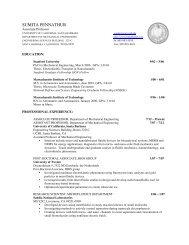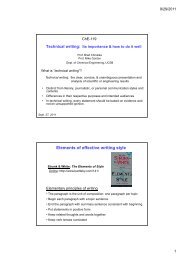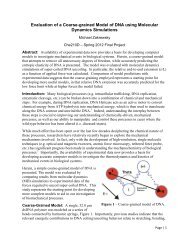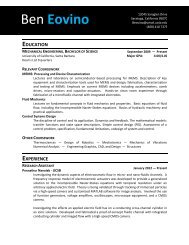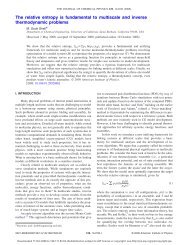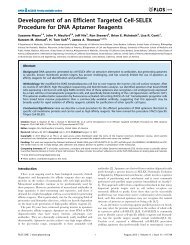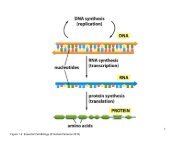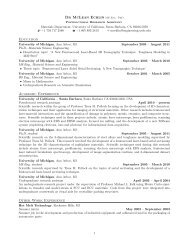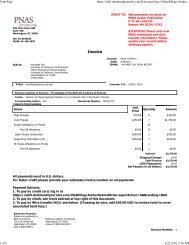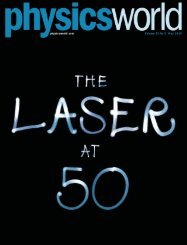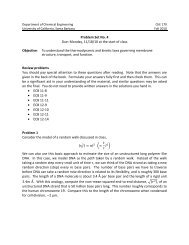Extensive thermodynamic potentials
Extensive thermodynamic potentials
Extensive thermodynamic potentials
You also want an ePaper? Increase the reach of your titles
YUMPU automatically turns print PDFs into web optimized ePapers that Google loves.
ChE 210A Thermodynamics and statistical mechanics<br />
<strong>Extensive</strong> <strong>thermodynamic</strong> <strong>potentials</strong> (single component)<br />
name independent variables differential form integrated form<br />
entropy<br />
, , <br />
1 <br />
<br />
energy , , <br />
enthalpy , , <br />
<br />
Helmholtz free energy , , <br />
<br />
Gibbs free energy , , <br />
<br />
<br />
<br />
Intensive <strong>thermodynamic</strong> <strong>potentials</strong> (single component)<br />
name independent variables differential form integrated relations<br />
entropy per-particle<br />
, <br />
1 <br />
<br />
<br />
<br />
energy per-particle , <br />
enthalpy per-particle , <br />
<br />
Helmholtz free energy per-particle , <br />
<br />
Gibbs free energy per-particle ,
ChE 210A Thermodynamics and statistical mechanics<br />
Measurable quantities<br />
name definition name definition<br />
pressure temperature <br />
volume heat of phase change Δ<br />
constant-volume heat capacity<br />
constant-pressure heat capacity<br />
<br />
<br />
<br />
<br />
isothermal compressibility<br />
thermal expansivity<br />
1 ln <br />
<br />
1 ln <br />
<br />
Thermodynamic calculus manipulations<br />
name applies to... functional form example<br />
inversion<br />
anything<br />
<br />
<br />
1 <br />
<br />
<br />
<br />
1<br />
<br />
<br />
triple product rule<br />
anything<br />
<br />
<br />
<br />
1<br />
<br />
<br />
<br />
<br />
<br />
<br />
<br />
Maxwell’s relations<br />
potential second<br />
derivatives<br />
<br />
<br />
<br />
<br />
<br />
<br />
<br />
<br />
addition of variable<br />
anything<br />
<br />
<br />
<br />
<br />
<br />
<br />
<br />
<br />
<br />
<br />
<br />
<br />
potential<br />
transformation<br />
<strong>potentials</strong> ⁄ <br />
<br />
<br />
<br />
⁄ <br />
<br />
nonnatural<br />
derivative<br />
anything<br />
, <br />
<br />
<br />
<br />
<br />
Note: Sometimes the notation is used instead of to indicate the <strong>thermodynamic</strong> internal energy.
ChE 210A<br />
Thermodynamics and statistical mechanics<br />
Derivations and memory techniques<br />
Triple product rule<br />
Take, as an example, the function , , although we could consider any state function. We know<br />
that the full differential is given by<br />
<br />
<br />
<br />
<br />
Now consider the case in which is held constant, such that 0. Then we can combine the<br />
differentials and at constant conditions.<br />
0 <br />
<br />
<br />
<br />
Rearranging and using the inversion rule gives the triple product rule:<br />
<br />
<br />
<br />
1<br />
<br />
How can you remember this It’s simple. Starting with one partial derivative, just rotate the variables<br />
by putting the constant one in the numerator, the numerator in the denominator, and the denominator<br />
in the constant. Do two rotations and remember the product is -1.<br />
Maxwell’s relations<br />
For constant conditions, as we have discussed here, there is a particularly convenient way to<br />
remember all the Maxwell relationships without having to go through all the derivations each time<br />
(although you should always be able to do so!). It’s called the “magic square”. Here is what it looks like:<br />
G P H<br />
T S<br />
A V U<br />
To get Maxwell relations from the magic square, you need to do draw arrows that swoop past the<br />
<strong>thermodynamic</strong> <strong>potentials</strong> along the side edges (not corners). Here is an example:<br />
G P H<br />
T S<br />
A V U<br />
The arrows indicate that <br />
<br />
. They both start at the numerator and end at the constant<br />
value. The potential they swoop by is , which is also the potential from which this Maxwell relation is
ChE 210A<br />
Thermodynamics and statistical mechanics<br />
derived. The negative sign comes from the fact that is in the top-left quadrant (think of it as negative<br />
x and positive y). Maxwell relations about also have a negative sign, but those for and do<br />
not.<br />
To remember the order of the magic square, start at the top left hand corner and use the mnemonic<br />
“Great people have studied under very able teachers.” (No egoism intended.)<br />
Potential transformation<br />
As an example, let’s prove ⁄ <br />
. To do this, start with the fact that<br />
Now, express as the derivative of :<br />
Divide both sides by :<br />
<br />
<br />
<br />
<br />
1 <br />
Now, the RHS can be expressed as a derivative using the chain rule, giving finally:<br />
Nonnatural derivative<br />
<br />
⁄ <br />
<br />
What if we know , , but want to find <br />
Here, is not one of the natural variables that can<br />
<br />
be held constant. We start by writing the full differential :<br />
<br />
<br />
<br />
<br />
<br />
Then, we divide through by the desired derivative, taken at constant :<br />
Substituting in some definitions gives,
ChE 210A<br />
Thermodynamics and statistical mechanics<br />
This procedure works with any complete state function, even with nonnatural variables. For example,<br />
starting with E, , we could show:<br />
<br />
<br />
<br />
<br />
<br />
Carrying this a little further, to get to measurable variables:<br />
<br />
<br />
<br />
<br />
<br />
<br />
<br />
<br />
<br />
<br />
<br />
<br />
<br />
<br />
<br />
<br />
<br />
<br />
<br />
<br />
<br />
<br />
Here, another nonnatural derivative was expanded in the first line, a Maxwell relation was used in the<br />
second, and the triple product rule was used in the third.




